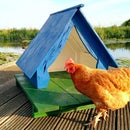Introduction: Vertical Zoo / Countdown Calendar
This project brings back my childhood memories. When I was a child, CDs did not exist and for sure we did not have a vertical zoo made from an old CD rack at home. But I do remember that when I was about 5 or 6 years old my dad took an image from a coloring book, transferred it to plywood with carbon paper and he gave me a jigsaw so I could saw the image from the wood. It was a basket with some flowers. The next day I showed it at school and my teacher said that it was very beautiful. Of course she would say that no matter what it looked like. But I was not aware of that and I was very proud that I used tools for grown ups and made my first DIY project.
Now we are many years later and CDs have become outdated. Once our CD-rack was completely full, but now the rack has become redundant. Therefore I decided to give it another purpose and to make a countdown calendar/ vertical zoo from the old CD-rack.
To make the animals for the zoo, I used the exact same method that my dad used all those years ago and I want to share it with you. Maybe you have a kid who has never worked with a jigsaw before and this will be his or her first project, which they will still remember many years from now. If the animals that I used are a bit too complicated to make, it is also possible to just saw the rough shape and print an image of an animal and glue that on the plywood. Or if you do not like wood, it is also possible to cut the animals from paper.
I also wanted some visitors in my zoo and decided to use the design for the marble snails from snowbiscuit.
You can see it herehttps://www.instructables.com/Marble-Snails/
And what about the countdown calendar?
Well, if you have children in the age that they are not really aware of time and they keep asking if some special moment like their birthday is already there, you can use this zoo as countdown calendar. Your children can pick an animal which they like and every night that animal climbs one level higher on the vertical zoo. At the moment that their chosen animal has reached the top, the special moment has come.
Supplies
Materials
For the zoo:
Old CD-rack
MDF, enough for the number of shelves you want to make. Thickness so it fits in your CD-rack
Plywood, I used 5.5 mm thick. A piece of 30x30 cm (12” x 12”) is enough.
Carbon paper
Paint
Glue
Nails
Thin wire, I used the type you would use for sewing.
For the snails:
3D printed bottoms, see instructable about the marble snails.
Wooden beads, 15 mm diameter
Step 1: Modify the CD Rack
The project starts with an old CD-rack. The one I used is probably not the same as any rack that you have, so I will only briefly describe what I did to modify my rack.
Mine was too high, so I used a hacksaw to cut off the larger slots at the bottom and drilled some new holes to reattach the rack to the base plate. Now the rack is also no longer tilting backwards.
I added a softer base from MDF so that the metal will not scratch my furniture.
Step 2: Cut Some Shelves From MDF
I used MDF of the same thickness as the CD-boxes and cut the first shelf the same size as the CD-box. I then decided that it would be nicer to make the shelves a bit wider alternating to the left and the right. It would have been better if I had used MDF of the same thickness as the slots, because now the extra weight at the sides caused the shelves to tilt. I solved that later by cutting some thin wooden strip to the same width as the shelves and to fill the gap at the top side of each MDF shelf.
Step 3: See What It Looks Like
I considered adding more shelves, but decided that 7 pieces is enough.
Step 4: Print the PDF Drawings
Print the drawings on regular size paper. If you do not like these animals you can also use other animals. I got the drawings from a coloring book.
Attachments
Step 5: Transfer the Animals to the Plywood
I used 5.5 mm thick plywood. That is 1/4" and that size worked well.
Use carbon paper to transfer the drawings to the wood.
Step 6: Use a Jigsaw to Cut the Wood and Sand the Edges
I used a jigsaw to cut my animals. If you have a scrollsaw, that probably works faster, but I do not have one. I do have a bandsaw and used that to cut the rough shapes.
Some parts can break easily, especially the tail of the mouse and the tail and arms and legs of the monkey. Cut them from the hand and foot towards the body so that it is less likely to break.
If you do not like to cut all these details, you can just cut the rough shape, and glue the drawing on the wood.
Use sandpaper or small files to sand the edges.
Step 7: Drill Holes for the Eyes
Drill holes for the eyes. It can help to make a dent first in the right spot with a hammer and a screw so your drillbit will not wander away.
Step 8: Paint
Paint the shelves with black paint and use a clear varnish for the animals.
I did not paint the sides of the MDF as I like the effect of the different color and the sides of MDF usually require many layers of paint.
Step 9: Print the Marble Snails From Snowbiscuit.
See link here to the instructable from Snowbiscuit. https://www.instructables.com/Marble-Snails/
I used wooden beads instead of marbles because the wood fits better with the colors of my zoo.
Also I did not make the horns of the snails. I allready like the snails without horn.
Step 10: Add Nails and Wire
I wanted the bird, the monkey and the butterflies to hang in the air. So I added nails at the two front corners of each shelf and drilled a hole and added a wire to hang the animals.
Step 11: Make a Base for the Other Animals So They Do Not Fall
I cut some wood to make a base for each animal, painted it black and glued the animal to it's base.
Step 12: Fill the Gaps at the Shelves
Because I used MDF that was thinner than the slots in the rack, each shelf tilted to the side. Therefore I cut some strips of wood just thick enough to fill the gap.
If you use MDF of the same thickness as the slots, you do not need these strips.
Step 13: Enjoy the Result
During day time I have daylight from the window behind the rack which shows the animals more as silhouette. At night time I have a light illuminating the zoo.
I like the result.





